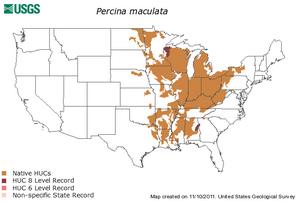Blackside darter facts for kids
Quick facts for kids Blackside darter |
|
|---|---|
| Conservation status | |
| Scientific classification | |
| Synonyms | |
|
Alvordius maculatus Girard, 1859 |
The blackside darter (scientific name: Percina maculata) is a cool type of freshwater fish. It belongs to a group of fish called ray-finned fish. This darter is part of the family called Percidae. This family also includes popular fish like perches.
Blackside darters live in streams and rivers. You can find them across the Mississippi River watershed. Like other darters, they love rocky areas and sandy spots in rivers. They can also live in calmer, still water. The Blackside darter is one of 324 fish species found in Tennessee.
Contents
What They Look Like
Blackside darters are easy to spot because they are usually olive green. Their colors are often dark, like browns, olives, and blacks. Sometimes they have white parts too. A key feature is a strip of 6 to 9 black spots along their sides. They also have black spots under their eyes and on their tail fin (which is called a caudal fin).
Most Blackside darters are about 2 to 3 inches long. Some can grow up to 4 inches! They have two fins on their back, called dorsal fins. The first dorsal fin has spiky, spinous rays. The second one has softer, soft rays. Their tail fin is rounded. The mouth of a Blackside darter is at the very front of its snout. This is called a terminal mouth.
Where They Live
Blackside darters live in small to medium-sized rivers and streams. These places need to be clean and mostly free of pollution. They prefer areas with slower currents. They also like places where they can hide, such as among roots or natural debris.
These fish are found across the United States. You can see them in the Hudson Bay area and the Mississippi River basin. They also live in Gulf drainages from Mobile Bay in Alabama to the Calcasieu River in Louisiana. They have been found in the Minnesota river basin and near the Great Lakes.
How They Reproduce
Blackside darters start their spawning season in spring. This usually begins around April and lasts until late June or early July. The fish swim upstream to find good spots. They lay their eggs over sand and gravel in slow, shallow areas of the river. They then bury the eggs.
After laying the eggs, the parents do not take care of them or the young fish. The young darters are born and grow up quickly. They become mature when they are one or two years old. Blackside darters can live for up to five years.
What They Eat
Blackside darters mostly eat insects. Their favorite foods include mayflies and midge larvae. They have also been known to eat other small fish and some plant material. Sometimes, they will also eat small crustaceans and other tiny aquatic animals.
Conservation Status
Since Blackside darters need clean streams to live, anything that pollutes their home can be very harmful. Garbage and pollution can wipe out groups of these fish if the changes are too sudden or last too long. However, overall, Blackside darters are not currently in danger. As a species, they are doing well.
Meaning of Their Name
The scientific name for the blackside darter is Percina maculata. The first part, Percina, comes from a Latin word. It means "small perch." The second part, maculata, also comes from Latin. It means "spotted." So, their name basically means "spotted little perch"!
See also
 In Spanish: Percina maculata para niños
In Spanish: Percina maculata para niños



